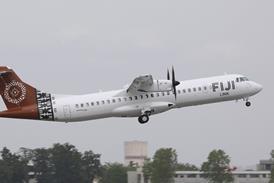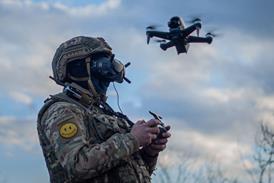The surprising success of the often-overlooked C-23B in Iraq has led the US Army to reassess the potentialfor short take-off and landing freighters
One of the more important lessons for the US Army in Iraq has been rediscovering the value of a light fixed-wing transport. The $1.3 billion Future Cargo Aircraft (FCA) programme has been an immediate consequence, but there are signs of a broader upheaval in military and industrial thinking on the potential for a long-neglected class of short take-off and landing (STOL) freighters.
The catalyst has been the surprising performance in Iraq of the National Guard Shorts C-23B Sherpa after a lifetime spent as an overlooked, low-end military shuttle. In the past two years, however, the Sherpa has earned a new reputation as a steady – if ill-equipped – battlefield workhorse.
“The guard and the army in general has done an amazing job in making the Sherpa do a lot more than they thought it could,” says an industry source.
For now, army officials publicly describe the FCA programme as a simple acquisition of 33 medium-lift transports by fiscal year 2011, with two candidates in the race: the Alenia C-27J and the EADS Casa C-295. They are to replace the army’s three passenger shuttles – the Sherpa, the Fairchild C-26 Metro and the Beechcraft C-12 King Air – with a common fixed-wing airlifter. But the cargo aircraft’s role is to be expanded to include frontline operations.
Funding
Although funding has been approved for only the first 33 aircraft, the army’s Training and Doctrine Command has defined a need for more than 120 FCA-type aircraft, with some to replace the retiring C-23B fleet and the rest to be used for homeland defence missions. This second role could re-emerge as a follow-on production order after the last planned FCA delivery in FY11.
Tellingly, the army’s budget justification documents submitted to Congress this year say the FCA procurement programme is planned to remain active until 2025, or 14 years longer than the proposed Sherpa replacement plan.
US industry officials are well aware of the potential for FCA spin-offs. Some US executives have likened the programme’s potential to that of the Sikorsky UH-60 helicopter. The Black Hawk entered service as a medium-lift utility helicopter for the army, but has blossomed with hundreds of additional orders in a variety of military and civilian roles. FCA orders also are expected to expand as it becomes operational and new uses for the aircraft are discovered.
Within the military, support for the FCA concept is quickly spreading beyond the army. This year, an FCA-like aircraft has been described as desirable by the US Air Force chief of staff and the head of the Air National Guard. Special Operations Command is widely considered to be another likely customer.
USAF chief of staff Gen John Jumper, who began his career as a de Havilland Canada C-7 Caribou pilot, has spoken of the need to work with the army to acquire a new class of transports about half the size of the Lockheed Martin C-130. Jumper has described a need for an aircraft that can reach small, remote units, such as the special-forces camps in Vietnam that he resupplied with the C-7.
The shift in military operations to fighting terrorists and insurgents has created the demand for the Sherpa-type aircraft, albeit with the speed and on-board defensive systems of a C-130.
“What it reflects is the change in the way in which the war on terror is being conducted vis-a-vis the way in which we knew it in the Cold War and shortly after that,” says Bob Drewes, president of L-3 Communications Integrated Systems, representing the Alenia-led GMAS team offering the C-27J. “We do not have large battlefields. We have smaller units that are more remote. It is crucial to resupply them. The Sherpa has shown the value for that medium-lift capability.”
However, the Congressional Research Service, an arm of the Library of Congress, cautions in a January report on the role of aviation in combating terrorists and insurgents that the reality of servicing aircraft near the frontline is a “considerable task”. The report also notes that the FCA programme is likely to “exacerbate an ongoing roles and missions tension between the air force and army”. The USAF and the army were entangled in a roles and missions dispute last year over the FCA, which led to speculation that air force leaders wanted to keep their monopoly on the tactical airlifter mission.
But the matter appears to have been resolved to the satisfaction of both parties. In the short term, the army is permitted to acquire the fixed-wing Sherpa replacement, but operations in any combat theatre would be controlled by the Joint Force Air Component Commander (JFACC), which is traditionally a post filled by a USAF officer.
This agreement has allowed the army to move forward with plans to obtain the Department of Defense’s approval for FCA this month, quickly followed by release of a draft tender. The final solicitation could be issued by October or November. The rival aircraft will be evaluated during a fly-off planned in April or May next year before a contract award in perhaps December.
Although US industry lacks an eligible airframe, which must have US Federal Aviation Administration certification and a rear cargo ramp, there is clear enthusiasm for lucrative deals for work such as systems integration, self-protection equipment and avionics, plus a possible final assembly site and long-term sustainment contracts.
Foreign manufacturers have been engaged with the US Army for several years on a Sherpa replacement. Alenia, for instance, cited the army’s potential requirement for a fixed-wing medium airlifter when launching the C-27J programme in the mid-1990s. CASA had been marketing light transports to the army since the late 1980s, making sales to the Special Operations Command. But the replacement for the Sherpa began to move forward only when the record of the aircraft’s performance in Iraq began to receive attention within the army in 2003.
The National Guard first deployed Sherpas to Kuwait in the early months of the Iraq occupation in August 2003. At the time, the army was desperate to relieve the operating burden on an overextended fleet of Boeing CH-47 Chinook helicopters, which require more maintenance downtime than a fixed-wing aircraft. Making fast shipments of such time-critical supplies as blood, food and water were also diverting the CH-47 from its natural heavylift mission.
The C-23B was tapped for the role, but not without grave concerns. With its top speed of 210kt (390km/h), the Sherpa is an easy target for surface-to-air missiles. So, much like a helicopter, this converted regional airliner must rely on nap-of-the-earth flying tactics to survive. Nonetheless, no C-23B has been lost and the fleet has been hauling about 500,000t of cargo a month in Iraq, relieving the CH-47s and truck convoys of huge burdens. Within a year of their initial deployment, the Sherpas were moved inside Iraq to a more central base in Balad.
New investment
Six months after the first C-23B deployment to Iraq, the army launched the FCA programme in February 2004. The cancellation of the $14.6 billion Boeing/Sikorsky RAH-66 Comanche helicopter allowed the army to make some new investments, and the C-23B’s record in Iraq had helped to raise the priority for the FCA programme.
The Sherpa has “saved our bacon” in Iraq, says Maj Gen James Pillsbury, commanding general of the US Army’s Aviation and Missile Command (AMCOM). Pillsbury also admits that, as a junior officer in the US Department of Defense 15 years ago, he fought a losing campaign to cancel the C-23B acquisition programme.
The National Guard acquired the aircraft in the late 1980s amid controversy. Senior military officials publicly argued that the guard did not need the Sherpas, but were being forced to buy them because of the intervention of Shorts’ supporters in Congress. As the US military began a massive drawdown in the early 1990s, critics of the Sherpa deal questioned why a small airlifter was needed at a time when other acquisition priorities were losing funding.
The guard’s quick decision to award the contract to Shorts also sparked protests from potential competitors, including Spain’s CASA, which was preparing to offer the C-212 as a candidate to replace the guard’s ageing C-7 Caribou fleet.
Nonetheless, Shorts, which had invested heavily in the home state of then-Senate appropriations committee chairman Robert Byrd, received a contract that eventually led to 38 aircraft being delivered. Another six C-23As were transferred to the guard by the US Air Force and upgraded to the C-23B configuration.
The first handful of C-23Bs delivered were immediately deployed to support Operation Desert Storm in 1990, but largely went unnoticed in the overall logistics effort. The Sherpas were used for resupply missions far behind the frontlines during the massive build-up that preceded the war.
The Sherpa fleet returned to the continental USA and performed a basic utilitarian role for the guard. The fleet garnered national attention only in 2000 when one of the original fleet of 44 C-23B crashed during a thunderstorm, killing all 30 guard and active-duty soldiers aboard. Although the fleet was beginning to show signs of increased age, the army had no defined plans or requirement to launch replacement programme even as Operation Iraqi Freedom moved forward.
However, from August 2003, the STOL freighter has proven its worth as a cheaper and more maintainable substitute for vertical lift, albeit with less flexibility than a helicopter. The C-23B, which is limited to a maximum load of 3,180kg (7,000lb), virtually created a niche mission for a small tactical airlifter, positioned between the roles of a helicopter and the relatively grand size of the C-130 Hercules.
Pillsbury again wants to see the ageing C-23B removed from the army inventory, but only so that it can be quickly replaced with a new STOL airlifter that is less vulnerable in combat and can haul at least four times the cargo three times as far.
Lockheed dropped
Alenia formed the GMAS team in February by dropping Lockheed as its lead marketing partner in the US market. Lockheed remains a key avionics and propulsion supplier, as do Honeywell and Rolls-Royce. L-3 Communications is also in the team for logistics support.
EADS unveiled its team in May at an army aviation conference, with US manufacturer Raytheon serving as the prime contractor, systems integrator and logistics provider.
The FCA’s budget plan and requirements documents have been approved by the army, and is now only awaiting a final approval by the DoD, which is expected by mid-August.
Both teams are in a pre-solicitation attack mode, with each competitor challenging the performance statistics cited by the other. The more esoteric arguments involve the questions of which aircraft can load and offload a Humvee faster, which manufacturer’s charts of troop-seating configurations are more truthful, and which cargo-bay cross-section more closely resembles that of the Chinook.
However, some of the most important points are undisputed. The C-27J has a larger maximum payload capacity, but can seat fewer passengers than the C-295. The C-295’s longer fuselage has more room for pallets, but the C-27J’s wider and taller cross-section is a better option for outsized cargo. The C-27J has a maximum speed of 310kt, compared with 260kt for the C-295. GMAS believes its trump card is that theC-27J was designed with the army’s requirements in mind. Time will tell. -
Stephen Trimble / Washington DC
Source: Flight International























